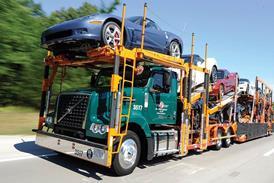
Block chains – the technology that already powers the virtual bitcoin currency – could soon be revolutionising information exchange in the automotive supply chain.
A block chain can be described as a digital ledger containing stringed blocks of information, similar to our DNA. And just like DNA, the block chain is not stored anywhere centrally, but distributed in multiple places (typically residing on many servers throughout the world). In the block chain, new transactions – like the transfer of a bitcoin from A to B – are simply added as a new piece of information at the end of the chain.
Encryption and automatic synchronisation of these distributed block chains make them a trusted public ledger that many can inspect, but no single user controls. And the technology provides full traceability in terms of who has done what, when and where. Consequently, it is clear – not least from a legal point of view – who owns the digital data recorded by such block chains.
The aim of bitcoins is to provide a decentralised system that avoids money being diverted into the wrong account and also prevents it from being spent twice by the same person. Bitcoin transactions are made without any third parties such as banks being involved – the third party is effectively replaced by the block chain, essentially just a database filled with the payment history of every existing bitcoin.
Scope in auto logisticsThe bitcoin remains the most high-profile example of the implementation of block chains but the technology has substantial potential in other fields, too – not least in automotive logistics. Block chain creator Satoshi Nakamoto built his technology as an open platform and invited others to elaborate on the system. Consequently, the tracking of any kind of asset could be carried out using block chain technology, which opens up a wide array of opportunities in logistics and supply chain management.
The technology could easily be used, for example, to optimise complex processes within the automotive industry, such as tracing each individual part back to its origin, with each supplier updating the block chain to provide a secure overall record of every vehicle component.
In finished vehicle logistics, meanwhile, where information is typically transferred among OEMs and 3PLs via complex interfaces that can leave service providers managing hundreds of different message types – an expensive and error-prone arrangement that frequently involves the use of proprietary systems – block chains could be used to build up a global ‘VIN ledger’ that would contain all the data relevant for the entire vehicle supply chain, including the logistics service providers involved.
The use of block chains in finished vehicle logistics would start with the OEM, who would add each new VIN into the block chain together with other relevant data, such as the vehicle's colour and model. Runtime data such as vehicle location, status and ownership/responsibility for the VIN would also be included. The OEM, as the party in charge, could then grant access to the vehicle’s information to their various supply chain partners, with each one of them accessing and updating the register as necessary.
The OEM might, for example, transfer access rights to the releasing agent at the factory compound, before going on to log the vehicle status as ‘ready for transport’, thereby granting a carrier access to its information. As each car left the factory compound, meanwhile, it could automatically result in the releasing agent losing access to the data as their involvement with the vehicle came to an end.
Compared to current information exchange procedures in finished vehicle logistics, block chain technology could do a lot to improve the efficiency of data management. With block chains, all participating parties would use the same platform to communicate about the various logistics processes. Increasing efficiency in this way would reduce costs as well as simplifying communications and coordination between the different levels of the supply chain.
Thrilling potentialAs a further thrilling possibility, block chains could assume an even more central role as ongoing developments in the automotive industry gather pace, such as car2car communication and autonomous vehicles.
In a world where access rights not just to the vehicle’s supply chain status but also to its onboard computer were granted via the block chain, a yard management system could instruct a self-driving car where to go to next – for example telling it to board a ship or drive to a particular loading area.
All the processes in the automotive supply chain could be automated in the same way, reducing the use of unnecessary resources and avoiding the transfer of incorrect information.
At the moment there have been fewer than 125m bitcoin transactions in total worldwide and it is obvious that the automotive sector, which produces around 90m vehicles every year, would far exceed this transaction number if it moved to block chain technology to manage its supply chain. But just as people are already contemplating a general ledger for the ‘Internet of Things’, so a similar VIN ledger should ultimately prove a manageable amount of data.
As block chain technology continues to develop, therefore, we seem certain to see a huge increase in its implementation in various supply chain and logistics processes – and the automotive sector, in particular, looks like it might just be at the very heart of such change.






















